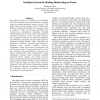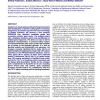164 search results - page 26 / 33 » Feature Descriptions for Context-oriented Programming |
HICSS
1998
IEEE
13 years 11 months ago
1998
IEEE
The National Institute of Standards and Technology (NIST) has developed a form-based handprint recognition system for reading information written on forms. This public domain soft...
GCB
1998
Springer
13 years 11 months ago
1998
Springer
Analysis of a newly sequenced bacterial genome starts with identification of protein-coding genes. Functional assignment of proteins requires the exact knowledge of protein N-term...
AGP
1994
IEEE
13 years 11 months ago
1994
IEEE
Kowalski and Sergot's Event Calculus (EC) is a formalism for reasoning about time and change in a logic programming framework. From a description of events which occur in the...
IPPS
1994
IEEE
13 years 11 months ago
1994
IEEE
Present-day parallel computers often face the problems of large software Overheadsfor process switching and interprocessor communication. These problems are addressed by the Multi...
EMSOFT
2006
Springer
13 years 11 months ago
2006
Springer
Among related synchronous programming principles, the model of computation of the Polychrony workbench stands out by its capability to give high-level description of systems where...


